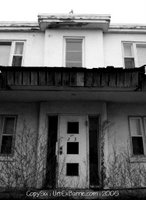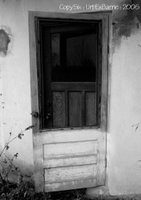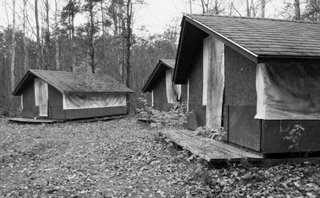Additional history on Muskoka Centre HERE.
Remember kids, the business end of a police dog is a dangerous place to be.
'sani tour3' banner by buddy Axle.
 The 3rd Muskoka Sanitarium Meet (aka Muskoka Centre) earlier this month was successful - co-operative weather, and no 5-0. There were at least 25 explorers on site for several fun-filled hours.
The 3rd Muskoka Sanitarium Meet (aka Muskoka Centre) earlier this month was successful - co-operative weather, and no 5-0. There were at least 25 explorers on site for several fun-filled hours.
The following miscreants were in attendance:
ace of spades, Aggressive, Axle, bandita, Boffo, Chinstrap, CopySix, Dark-Pariah, Dee, ElectricFire, faded_x, journeylady, Jupiter, K-Dizzle, Kellogs, levacas, LostintheWoods, lsd, Melt, neX_, Nonick, OneDeadHero, RegularJohn, ScreamingUrineMonkey, simmorill, SlipperyPete, and Vigilante.

The above serene scene of the group photograph was preceded by this chaos. The standard 10-second camera timer presented a unique challenge.
Photo Credit - Our girl JourneyLady.

The reliability of transport for event attendees were questionable at best.
 simmorill drove the group crazy (again).
simmorill drove the group crazy (again).

Not many are aware that most buses are NOT equipped with 'Auto-Pilot'.
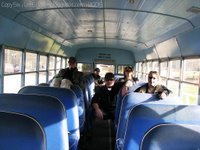
This group of 'special' people had miles of smiles.
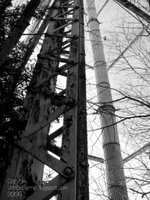
The water tower on the property provides a familar landmark visible for boaters on Lake Muskoka.
 It required a special breed of social care worker to be able to take a mentally handicapped person in a small boat on a big lake.
It required a special breed of social care worker to be able to take a mentally handicapped person in a small boat on a big lake.
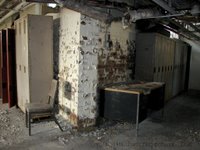 This being the third such occassion visiting the property, this explorer wanted to get to areas not previously probed.
This being the third such occassion visiting the property, this explorer wanted to get to areas not previously probed.
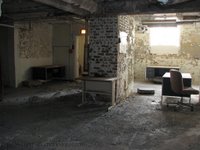
However, I still could not help revisiting the grand Gage building again.

Going to great lengths to avoid the so-called 'healthy' fresh air, explorers made use of the steam tunnels to safely move about.
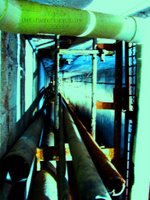
Light-headed from glee, or perhaps malfunctioning boiler equipment, these tunnels presented a trippy experience.

Here in the boiler house, the wall bracket waits for time cards which will never come.

Forever mischievous, some members changed into uniform and proceeded to scare other explorers (could have happened).

Quiet Riot was an important part of the early 80's glam-metal scene. Speaking of riots, how about this shelf of nifty lids.

In great need of refreshment, the discovery of the O.P.P. beer fridge was very welcome.
 Axle, neX_, Kimeleon, Gazoo and yours truly, CopySix, take a load off. The upholstery was rather dated and in dire need of repair.
Axle, neX_, Kimeleon, Gazoo and yours truly, CopySix, take a load off. The upholstery was rather dated and in dire need of repair.
Photo credit - Axle again !

Remember kids, the business end of a police dog is a dangerous place to be.
'sani tour3' banner by buddy Axle.
 The 3rd Muskoka Sanitarium Meet (aka Muskoka Centre) earlier this month was successful - co-operative weather, and no 5-0. There were at least 25 explorers on site for several fun-filled hours.
The 3rd Muskoka Sanitarium Meet (aka Muskoka Centre) earlier this month was successful - co-operative weather, and no 5-0. There were at least 25 explorers on site for several fun-filled hours.The following miscreants were in attendance:

ace of spades, Aggressive, Axle, bandita, Boffo, Chinstrap, CopySix, Dark-Pariah, Dee, ElectricFire, faded_x, journeylady, Jupiter, K-Dizzle, Kellogs, levacas, LostintheWoods, lsd, Melt, neX_, Nonick, OneDeadHero, RegularJohn, ScreamingUrineMonkey, simmorill, SlipperyPete, and Vigilante.

The above serene scene of the group photograph was preceded by this chaos. The standard 10-second camera timer presented a unique challenge.
Photo Credit - Our girl JourneyLady.

The reliability of transport for event attendees were questionable at best.
 simmorill drove the group crazy (again).
simmorill drove the group crazy (again).
Not many are aware that most buses are NOT equipped with 'Auto-Pilot'.

This group of 'special' people had miles of smiles.

The water tower on the property provides a familar landmark visible for boaters on Lake Muskoka.
 It required a special breed of social care worker to be able to take a mentally handicapped person in a small boat on a big lake.
It required a special breed of social care worker to be able to take a mentally handicapped person in a small boat on a big lake. This being the third such occassion visiting the property, this explorer wanted to get to areas not previously probed.
This being the third such occassion visiting the property, this explorer wanted to get to areas not previously probed.
However, I still could not help revisiting the grand Gage building again.

Going to great lengths to avoid the so-called 'healthy' fresh air, explorers made use of the steam tunnels to safely move about.

Light-headed from glee, or perhaps malfunctioning boiler equipment, these tunnels presented a trippy experience.

Here in the boiler house, the wall bracket waits for time cards which will never come.

Forever mischievous, some members changed into uniform and proceeded to scare other explorers (could have happened).

Quiet Riot was an important part of the early 80's glam-metal scene. Speaking of riots, how about this shelf of nifty lids.

In great need of refreshment, the discovery of the O.P.P. beer fridge was very welcome.
 Axle, neX_, Kimeleon, Gazoo and yours truly, CopySix, take a load off. The upholstery was rather dated and in dire need of repair.
Axle, neX_, Kimeleon, Gazoo and yours truly, CopySix, take a load off. The upholstery was rather dated and in dire need of repair.Photo credit - Axle again !
This image reminded me that not long ago, when the 'Cottage Sanitarium' was in operation on this site, many tuberculosis patients, checked out but never left.




